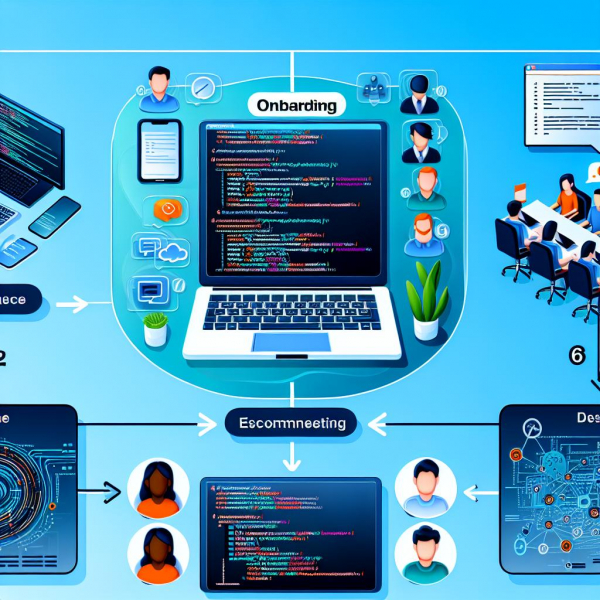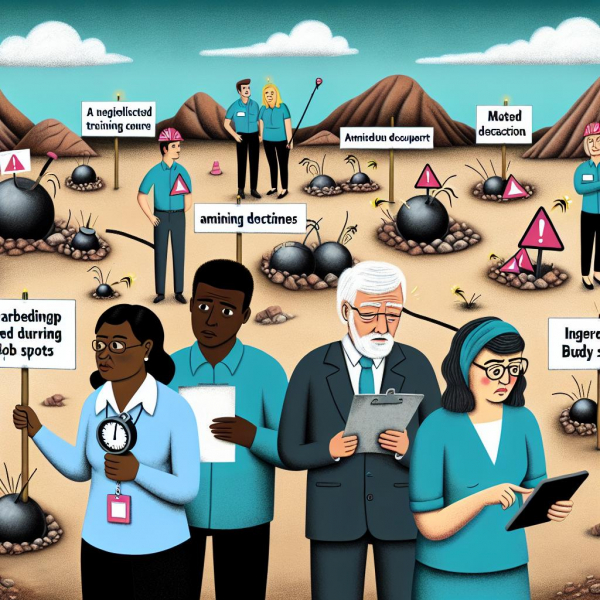Welcome to the realm of remote teams, where geographical barriers are shattered, cultural diversity thrives, and productivity soars across borders. In this age of digital nomads and virtual collaborations, onboarding a remote developer can be both a thrilling adventure and a labyrinth of challenges. As the key to unlocking the gates of success lies in embracing the world of remote work, we embark on a journey to navigate the treacherous terrain of onboarding pitfalls and discover the secret to nurturing a harmonious bond with our elusive yet talented remote developers. So, fasten your seatbelts, fellow adventurers, as we uncover the traps to avoid and unveil the wisdom that awaits us on this remote onboarding expedition.
Table of Contents
- Tips for Successfully Onboarding a Remote Developer
- Avoiding Common Traps During the Onboarding Process
- Ensuring Effective Communication from Day One
- Setting Clear Expectations and Goals for the Remote Developer
- Providing Adequate Support and Resources for a Seamless Transition
- Establishing a Strong Virtual Team Culture
- Offering Ongoing Feedback and Evaluation for Continuous Improvement
- Q&A
- Final Thoughts

Tips for Successfully Onboarding a Remote Developer
Remote work has become increasingly popular in recent years, and onboarding a remote developer can present unique challenges. To ensure a smooth and successful onboarding process for your new remote team member, there are a few traps to avoid and tips to keep in mind.
One major trap to avoid is neglecting proper communication. Remote developers rely heavily on clear and concise communication to understand their role, goals, and tasks. It is crucial to establish regular check-ins, whether through video conference calls or instant messaging tools, to provide guidance, answer questions, and offer support. Additionally, setting up a project management tool can help organize tasks, deadlines, and priorities, ensuring everyone is on the same page. Remember, consistent and effective communication is key to a successful onboarding experience.
Another trap to avoid is overlooking the importance of building rapport and fostering a sense of teamwork. Although the new developer may be physically distant, it is essential to create an inclusive and collaborative environment. Encourage virtual team-building activities such as icebreaker sessions or weekly video chats to foster bonds and cultivate a sense of belonging. Additionally, consider creating a buddy system, pairing the new remote developer with an experienced team member who can provide guidance and support during the onboarding process. By focusing on building relationships and promoting teamwork, you can help remote developers feel connected and engaged with the rest of the team.
In summary, successful onboarding of remote developers requires effective communication and team-building efforts. By avoiding communication pitfalls and prioritizing rapport, you can create a welcoming environment and set your remote developer up for success.

Avoiding Common Traps During the Onboarding Process
When onboarding a remote developer, it’s important to be aware of common traps that can lead to a rocky start. By avoiding these pitfalls and following some useful tips, you can set your new team member up for success.
Tips for Avoiding Traps:
- Establish clear communication channels: Make sure to set up regular check-ins and provide multiple platforms for team collaboration such as video conferencing, chat tools, and project management software.
- Create a comprehensive onboarding plan: Outline the tasks, goals, and expectations for the new developer, ensuring they have a clear roadmap to follow.
- Assign a mentor: Pair the remote developer with an experienced team member who can provide guidance, answer questions, and help them navigate the company’s culture and processes.
- Provide adequate resources: Equip the remote developer with the necessary tools, software, and access to documentation to effectively carry out their responsibilities.
Tips for Success:
- Encourage open communication: Foster an environment where the remote developer feels comfortable asking for clarification or voicing concerns.
- Set realistic expectations: Clearly define the remote developer’s responsibilities and let them know what deliverables are expected within specific timelines.
- Offer opportunities for professional growth: Provide access to training or conferences that can enhance their skills and knowledge, helping them feel like a valued member of the team.
- Regularly assess progress: Conduct performance evaluations and provide constructive feedback to ensure the remote developer is meeting expectations and has the opportunity to improve.

Ensuring Effective Communication from Day One
When onboarding a remote developer, it is crucial to establish effective communication from the very beginning. Without clear and open lines of communication, misunderstandings and errors can easily occur, leading to delayed progress and ultimately impacting the success of the project. To avoid these pitfalls, here are some traps to avoid and tips for success:
1. Set clear expectations: Clearly define project objectives, timelines, and deliverables. Providing the remote developer with a detailed project outline will help them understand their role and responsibilities, enabling them to align their efforts accordingly.
2. Utilize collaboration tools: Embrace the power of technology by using collaboration tools that facilitate seamless communication. Whether it’s project management platforms like Trello or communication tools like Slack, these platforms can help create a virtual workspace that promotes effective collaboration and eliminates communication gaps.
| Traps to Avoid | Tips for Success |
|---|---|
| Lack of clarity in instructions | Provide clear and concise instructions; ask the developer to repeat back for confirmation. |
| Poor availability for discussions | Set regular check-ins or meetings to address any questions or concerns promptly. |
| Miscommunication due to language barriers | Encourage open dialogue and create a safe space for the developer to ask for clarification. |
3. Foster a culture of feedback: Establishing regular feedback loops is essential for remote developers. Encouraging them to provide feedback on processes, challenges faced, and suggestions for improvement can greatly enhance the effectiveness of communication. Similarly, providing constructive feedback to the developer allows for continuous growth and improvement.
4. Be mindful of time zones: Remote developers may be located in different time zones, making synchronous communication challenging. Clearly communicate working hours and availability, and when necessary, find mutually agreeable meeting times that accommodate both parties.

Setting Clear Expectations and Goals for the Remote Developer
One of the key factors in successfully onboarding a remote developer is setting clear expectations and goals from the start. Without clear guidelines, both the developer and the company can find themselves struggling to align their objectives and working towards different outcomes. To avoid any potential pitfalls and ensure a smooth onboarding process, here are some tips:
- Define project scope and deliverables: Clearly communicate the specific tasks and projects the remote developer will be working on. Break down the scope into smaller, achievable deliverables with agreed-upon deadlines.
- Establish communication channels: Determine the primary communication channels for the remote developer to interact with the team, whether it’s through email, Slack, or video calls. Provide clear expectations on responsiveness and availability, taking time zone differences into consideration.
- Set performance metrics: Develop measurable performance metrics that tie into the remote developer’s goals. These metrics can include code quality, meeting deadlines, or completing tasks within estimated timeframes. Regularly evaluate and provide feedback based on these metrics to promote continuous improvement.
| Expectations | Goals |
|---|---|
| Clear communication | Improve team collaboration |
| Adherence to deadlines | Enhanced project efficiency |
| Code quality | Higher software reliability |
By setting clear expectations and goals, the remote developer will have a clear understanding of what is expected of them, leading to greater productivity and efficiency. It also allows the company to monitor progress and ensure that the remote developer aligns with the overall project objectives. Regular, open communication is crucial to address any issues or roadblocks that may arise, fostering a positive and successful working relationship.
Providing Adequate Support and Resources for a Seamless Transition
As you onboard a remote developer, it is crucial to ensure they have the necessary support and resources to make their transition smooth and successful. Here are some tips and traps to avoid:
- Establish clear communication channels: Maintaining effective communication between the remote developer and the team is vital. Utilize messaging tools like Slack or Microsoft Teams to facilitate instant communication, encourage collaboration, and avoid any miscommunication or delays.
- Document knowledge and processes: Create a comprehensive knowledge base or wiki that houses all essential information about your company’s processes, systems, and best practices. This resource will serve as a go-to guide for the new developer and help them quickly familiarize themselves with your organization.
- Assign a dedicated mentor: To accelerate the remote developer’s integration, assign an experienced team member to be their mentor. This mentor will provide guidance, answer questions, and ensure that the remote developer feels supported throughout their onboarding journey.
- Provide necessary tools and equipment: Ensure the remote developer has access to all the tools, software, and hardware they need to perform their job efficiently. This includes providing them with a reliable computer, software licenses, and any specialized equipment relevant to their role.
- Regular check-ins and feedback: Schedule regular check-ins to gauge the remote developer’s progress, address any concerns they may have, and provide constructive feedback. Regular feedback loops will help them understand their strengths and areas for improvement, fostering continuous growth and alignment with your team’s goals.
Remember, successful onboarding is an ongoing process, and providing adequate support and resources will contribute to a seamless transition for the remote developer. By implementing these tips and avoiding common traps, you can set your newly onboarded remote developer up for long-term success.
Establishing a Strong Virtual Team Culture
In order to establish a strong virtual team culture, it is essential to prioritize effective onboarding for remote developers. Avoiding common traps and implementing success-driven tips can make all the difference in building a cohesive and productive virtual team.
Foster a welcoming environment: From day one, ensure that the remote developer feels welcomed and valued. Assign them a buddy or mentor who can guide them through the onboarding process and answer any questions they may have. Encourage team members to reach out and introduce themselves, fostering open lines of communication and camaraderie. Additionally, hosting virtual coffee breaks or team-building activities can help establish connections and create a sense of belonging within the virtual team.
Establish clear goals and expectations: Clearly defining goals and expectations not only helps the remote developer understand what is expected of them, but also ensures that they can measure their own success. Provide them with a detailed onboarding plan that outlines their responsibilities, deadlines, and milestones. Regularly communicate progress and provide constructive feedback to keep them on track and motivated. By setting clear goals and expectations, you create a sense of direction and purpose within the virtual team, driving everyone towards a collective vision.
| Remote Developer | Tasks | Status |
|---|---|---|
| John | Review existing codebase | In progress |
| Sarah | Attend team meeting | Completed |
| Eric | Submit first project draft | Pending |
Remember, successful onboarding of remote developers goes beyond just paperwork. It involves creating a supportive and inclusive environment, providing them with the necessary tools and resources, and setting clear expectations. By putting in the effort to onboard efficiently, you are laying a strong foundation for a thriving virtual team culture.
Offering Ongoing Feedback and Evaluation for Continuous Improvement
Ongoing feedback and evaluation are essential components of successfully onboarding a remote developer. By providing regular feedback and evaluation, you can ensure that the developer understands their performance, areas for improvement, and expectations. This continuous improvement process helps both the developer and the organization to achieve their goals effectively and efficiently.
To offer ongoing feedback and evaluation for continuous improvement, here are some helpful tips:
- Set clear expectations: Clearly outline the goals, responsibilities, and performance standards for the remote developer. This establishes a foundation for regular feedback and evaluation.
- Regular check-ins: Schedule regular check-in meetings to discuss progress, address any concerns, and provide constructive feedback. These meetings can be conducted through video calls or messaging platforms.
- Use performance metrics: Implement objective performance metrics to evaluate the developer’s progress. This can include measuring their coding efficiency, meeting deadlines, and successfully completing tasks.
| Benefits of Ongoing Feedback and Evaluation |
|---|
| Improves communication and collaboration |
| Identifies areas of improvement |
| Boosts motivation and engagement |
| Enhances overall performance and productivity |
In addition to these tips, it’s crucial to create a supportive and open environment where the developer feels comfortable asking questions, sharing their challenges, and seeking guidance. By continuously providing feedback and evaluation, you can foster growth, enhance skills, and ensure the success of your remote developer.
Q&A
Q: Want to learn the secrets of successfully onboarding a remote developer?
A: Dive into our article to discover the traps to avoid and tips for ensuring a smooth onboarding experience.
Q: What are the challenges of onboarding a remote developer?
A: Onboarding a remote developer brings unique challenges such as establishing effective communication, building team cohesion, and ensuring clarity in project expectations.
Q: How can communication be improved during the onboarding process?
A: Clear and consistent communication is key. Utilize various channels like video conferencing, instant messaging, and project management tools to foster real-time conversations and keep everyone on the same page.
Q: How can team cohesion be fostered when the team is physically dispersed?
A: Although remote, it’s crucial to create a sense of camaraderie among team members. Encourage virtual team-building activities, promote cross-functional collaboration, and establish regular check-ins to maintain a strong team connection.
Q: How can project expectations be clarified for a remote developer?
A: Detailed documentation, including clear project goals, expectations, and timelines, should be provided to the remote developer. Conduct regular video meetings to discuss progress and address any questions or concerns.
Q: Are there any potential traps to avoid during the onboarding process?
A: Absolutely! It’s essential to avoid common traps like inadequate communication, vague project instructions, lack of technical resources, and insufficient support for remote tools.
Q: How can companies ensure a positive onboarding experience for remote developers?
A: Companies should invest in comprehensive onboarding programs tailored specifically for remote developers. These programs should include detailed documentation, virtual training sessions, mentorship opportunities, and continuous support to make remote developers feel valued and included.
Q: Are there any additional tips to ensure success in onboarding a remote developer?
A: Yes! Emphasize the importance of work-life balance, provide remote developers with the necessary hardware/software, ensure proper internet connectivity, promote frequent feedback and recognition, and encourage a supportive and inclusive work culture.
Q: Any final thoughts on onboarding remote developers?
A: Onboarding a remote developer effectively requires careful planning, open communication, and a supportive work environment. By avoiding common pitfalls and implementing our tips, companies can set their remote developers up for success and foster a strong and productive team dynamic.
Final Thoughts
As we conclude this insightful journey through the realm of onboarding a remote developer, it is essential to reflect on the pitfalls to steer clear of and the pearls of wisdom to embrace for a successful venture. The uncharted territory of remote collaboration may seem daunting at first, but armed with a discerning eye and an open mind, both employers and developers can forge a path towards seamless integration and lasting accomplishments.
As the world continues to evolve, so does our understanding of work and the boundaries that once constrained us. Embracing remote work has become a necessity, and with it, the art of onboarding has transformed into an intricate web of opportunities. However, be wary of the traps that wait to ensnare the unwary traveler along this path. Communication breakdowns, lack of support, and cultural misunderstandings are but a few of the snares lurking in the shadows. But fear not, for we have traversed these treacherous paths and returned with priceless wisdom to share.
Firstly, never underestimate the power of clear communication. In the realm of remote collaborations, misunderstandings can snowball into disasters with astounding speed. Maintain a constant flow of feedback, establish regular check-ins, and foster an environment where questions are warmly welcomed. Let your voice resonate across time zones, as clarity becomes your guiding light.
Secondly, remember that remote onboarding is not a solitary endeavor. Support your new developer with the tools and resources they need to flourish. Create a comprehensive onboarding plan tailored to their unique needs, provide access to necessary software and documentation, and ensure their integration with the team is seamless and inclusive. Only through unity can we unlock the true potential of remote collaborations.
Lastly, immerse yourself in the rich tapestry of cultures that remote work cultivates. Understand that diversity is a boon, not a hurdle. Embrace the unique perspectives and experiences your new developer brings to the table, and encourage them to share their ideas openly. By doing so, you create an environment that fosters innovation and growth, where harmony complements diversity, and where greatness can be achieved.
As we bid adieu to the realm of onboarding remote developers, armed with the awareness of potential traps and the tools for success, we look towards a future where borders dissolve, and the world becomes our workspace. Let us endeavor to build a bridge from afar, forging lasting connections that defy physical distance. Together, we can navigate the vast sea of remote work, always mindful of the traps that lie in wait, as we embark on this remarkable journey towards a brighter, more connected society.
